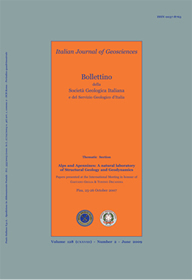
Climatic and tectonic control on the distribution of the Oligocene reefs of the Tertiary Piedmont Basin (NW Italy)
Francesca Quaranta(*), Michele Piazza(*) & Grazia Vannucci(*)
(*) DIP.TE.RIS. - Università degli Studi di Genova - Corso Europa, 26 - 16132 Genova, Italy; 0103538286 - mpiazza@dipteris.unige.it.
Volume: 128 (2009) f.2
Pages: 587-591
Abstract
The Tertiary Piedmont Basin (TPB) stretches along the Piedmont-Liguria border and is a late- to post-orogenic basin that evolved in a piggy-back position on the Monferrato thrust belt. Its depositional story is strongly controlled by tectonic and eustatic events. The basin was filled with mainly marine sediments (upper Eocene-upper Miocene), which unconformably overlie the Ligurian Alps and the Northern Apennines. The early stage of sedimentation of TPB records a transgressive phase (time-transgressive from the eastern to the western sectors, upper Eocene-upper Oligocene), characterized by the deposition of alluvial fan and fan delta siliciclastic conglomerates and sandstones, marine shallow-water coarse to fine grained siliciclastic sediments, and reef limestones.
The TPB reefal buildups, which developed close to the paleoshoreline, have a lower Rupelian-middle Chattian stratigraphic distribution and are restricted to the central part of the southern margin of the TPB. The Valzemola-San Bernardino reef is the younger and the westernmost settlement, while the Val Lemme reef represents the older and easternmost one.
The depicted stratigraphic and geographic distribution may be the result of a combined climatic and tectonic control. The lack of reef settlements west of Valzemola-Bric S. Bernardino may be due to climatic condition unfavourable for the reef development (temperature cooler than those of the early Rupelian-middle Chattian time interval). The absence of reefs in the area to the east of Val Lemme may be the consequence of bottom instability and high sedimentation rates (unfavourable conditions for the reef development) caused by the syn-sedimentary tectonic activity along the Scrivia fault, during the time interval spanning from the late Eocene to the early Oligocene (notwithstanding the favourable climatic conditions).
Finally, the age of the older reefal complex, i.e. early Rupelian (Val Lemme), gives an obvious constraint to the age of the end of the N-vergent thrusting phase of the Voltri Unit onto the flysch units and its sedimentary cover.
Keywords
Get Full Text